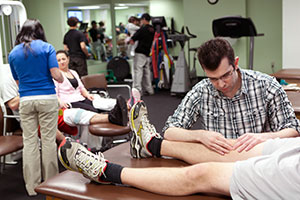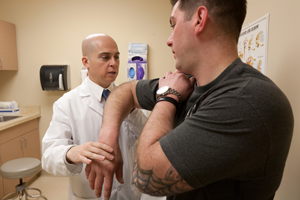- Locations
- Find a Physician
- By Physician
- By Department
- The Center for Spine Health
- Hand & Wrist Center
- Shoulder & Elbow Center
- Foot & Ankle Center
- Joint Replacement Center
- The Sports Medicine Center
- Pediatric Orthopedic Center
- Trauma & Fracture Center
- Osteoporosis and Bone Health
- Oncology Center
- Cartilage Repair Center
- Concussion Rehab Center
- OrthoDirect
- Careers
- Patient Portal
- Intranet
Non Surgical Options
The trend in orthopedics and spine is for a specialist to exhaust all non-surgical treatment options in advance of surgery. That’s because the more invasive (surgical) the treatment option, the more tissue is disrupted and there is more potential for more complications than with therapy or a injection.
For example, with back pain, including low back pain, and neck pain, non-surgical treatment is very important because spine surgery is complex, often requiring an overnight stay in the hospital. To gain access to the spine the spine surgeon, may need to access the spine through the abdomen or back, which can require disruption to tissues and muscles, which in turn causes time for recovery and rehabilitation. Also, many times symptoms from disc herniations can disappear with non-surgical treatment options. 
So if you are impatient, wanting a quick fix to your problem, keep in mind that the best specialists in orthopedics, sports medicine and spine will first look at if there are non-surgical options for you to try first before surgery.
With sports medicine problems involving strain, sprain or overuse syndrome, non-surgical treatment options like anti-inflammatory medication, injections into a joint space or specialist therapy, can many times provide relief of symptoms without the need for surgery.
The other aspect to non-surgical emphasis can be to address the underlying cause of your pain symptoms. In the United States, for example, research studies have shown that half of the population is overweight, and one in four Americans is categorized as “obese.” The grim reality is that the human knee, for example, was never designed to support a 350 pound person. Over time, excess weight will simply destroy a knee joint, requiring knee replacement. But merely replacing that knee joint, without addressing the obesity causing the problem, will in turn destroy the new artificial knee joint. Because of the nature of a knee replacement surgery, a person can typically have only two knee replacements in their lifetime before they become wheelchair bound.
When surgery is the best route
When there is a fracture, completely torn ligament (e.g. torn anterior cruciate ligament in the knee), or a badly degenerated joint (e.g. arthritic hip joint or damaged knee joint), or a badly herniated disc, the only real option may be surgery.
Also, if you have tried therapy and injections for two months, then the next step may be surgery to resolve your problem and get you back to activity.
We understand that you are eager to get back to activity, and the physicians at University Orthopedics will help you reach that goal. Keep in mind that our team of sports medicine, orthopedic and spine specialists are recommending the best long term options for your care. We are on your team for the long haul.
[Top]








